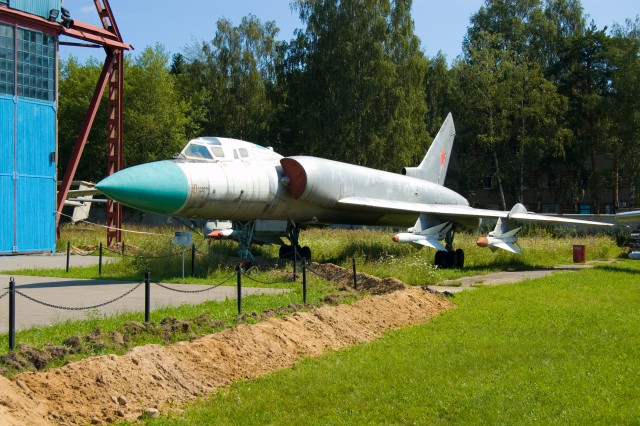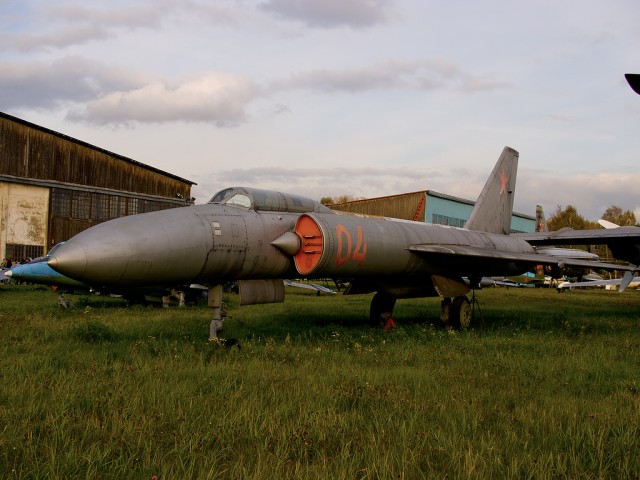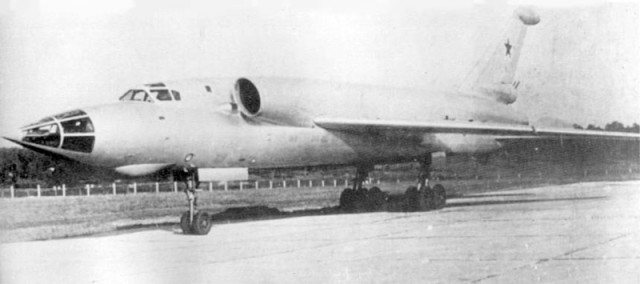Before I get into the aircraft I want to discuss today, there is an important matter of Soviet Military organization that I see misconstrued often. During the Soviet times, the VVS (Voyenno-Vozdushnye Sily or Military Air Force) was not responsible for matters of air defense.
This was the auspice of the PVO, sometimes also abbreviated as V-PVO (or sometimes PVO strany). PVO is a Russian abbreviation that literal translates to anti-air defense; strany is Russian for country (sometimes nation). So PVO strany was responsible for the anti-air defense of the nation. They were considered the third-most important branch of the Soviet Armed Forces (behind the RVSN and Ground Forces). While the PVO was merged into the VVS in 1998, their legacy lives on; Air Defense Day is celebrated on the second Sunday of every April.
This, if it was not obvious yet, is a story about an aircraft that served with the PVO. Some would say, the most unusual of them as well.
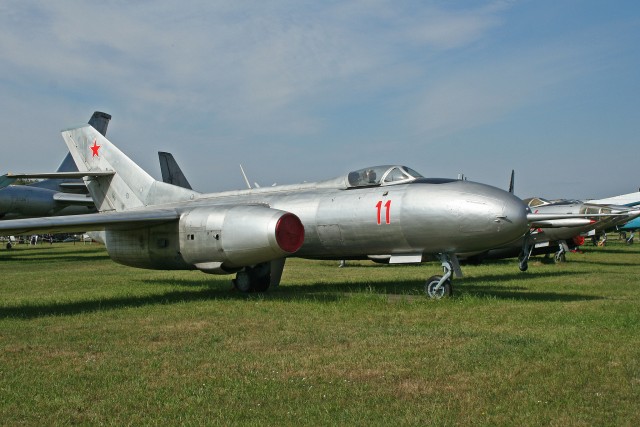
Yakolev Yak-25RV-II ’11 red’ – Photo: Alan Wilson | Flickr CC
In the early 1950s, it became apparent that even with the Soviet Union spending a huge proportion of its GDP on the military, there just would not be the budget necessary to cover all 3,107 miles of their northern coastline with a modern, integrated, air defense network. However, sovereignty has always been a matter of might over right, so something had to be done to at least provide some air defense cover to the less-populated and tactically important areas of the country. It also became apparent that the PVO’s then front-line, long-range interceptor, the Yak-25, would be woefully insufficient to deal with the potential onslaught of American jet-bombers.
The PVO, being highly political, ignored the first part of their own realization and decided that they should focus their efforts on the defense of Moscow. In 1953, the Lavochkin OKB approached the PVO with an entire system that would do just that. Called Berkut, Russian for Golden Eagle, the system would incorporate a series of ground-based radars, surface-to-air missiles, as well as ground-controlled interceptor aircraft. Lavochkin had also designed an air-to-air missile called the G-300.
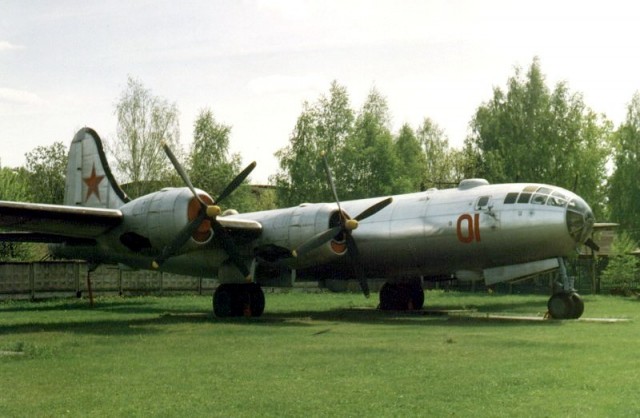
A Tu-4 located at the Monino museum – Photo: jno | Wiki Commons
This missile would be based off of very early radar technology that used thousands of vacuum tubes. At a weight of approximately 2,200 pounds, no Soviet fighter could carry it. Instead, Lavochkin’s missiles were to be carried on the wings of a modified Tu-4. This monstrosity of an anti-air weapon would only have a maximum range of 9.3 miles but a ceiling of 66,000 feet. Incredibly, ten test-firings were done from the system (dubbed G-310) before it was declared to be a terrible idea and cancelled.
While the fixed-wing portion of Berkut end (the ground-based part becoming the venerable S-25 SAM), the idea lived on in another way. November of that year saw a requirement issued for what was called “Kompleks 15” or K-15. It was to be an air defense system that consisted of an “interceptor 250”, a ground control unit, and a missile known simply as “275”.
On top of the fact that “interceptor 250” was to carry two of these 1920lb monstrosities, the PVO also decided that the aircraft needed sufficient range to meet the marauding American formations before they got too close to the populated areas of the motherland. K-15 also stipulated that the authority (and ability) for the aircraft to fire its missiles actually be done from the ground control station. If it’s not already apparent from the requirements, this would call for a very large aircraft; one that could also exceed the speed of sound.
Nearly 88-feet long and weighing in at 60,500 pounds at max gross, “interceptor 250” became the Lavochkin LA-250. The immediate flaw was relatively simple – the expected engines, designed by Klimov, were nowhere to be found. Instead, Lyulka AL-7Fs were installed as a substitute.
Five aircraft were built, but in total they only made 21 flights between 1956 and 1958. The aircraft was terrible. It was underpowered, prone to hydraulic and landing gear failures, and suffered from poor cockpit visibility on landing. While none of the crashes were fatal, the PVO grew frustrated with the program and cancelled it in early 1959.
Lavochkin would never design another aircraft. They would go on to produce the extremely successful S-75 Dvina surface-to-air missile, but that was after the death of Semyon Lavochkin.
Meanwhile, with Kruschev in the full swing of his consolidation of power- the Soviet Union’s designers were being directed to embrace the socialist-realist style of becoming technological supermen. Entire aircraft programs were being scrapped because Kruschev himself deemed their designs old-fashioned. There were opportunities afoot, as well. While the folks over in Lefortovo were trying to capitalize on these using a requirement for a new, supersonic, strike bomber, they would come up with a 105-foot long aircraft that could do just that.
This was the Tu-98. Shown to an American delegation for reasons that are apparently still unknown, it was dubbed Backfin by NATO. 105-feet long and also powered by the same Lyulka AL-7F engines, it was indeed capable of supersonic flight. That said, as a bomber its payload was quite limited (a mere 11,000lbs). The requirement for a frontal-bomber changed, leading to the production of the Yak-28 (a much smaller aircraft). When it was obvious that this aircraft was not useful, Tupolev abandoned it.
Usually, when projects in the Soviet Union were cancelled by the design bureau or the government, that was the end. Sometimes the test articles would be put on display at Monino to be gawked at by aviation enthusiasts and students, but that was really the extent of their legacy.
Not this time.
Designing a supersonic aircraft of that size was always going to come at great cost. Internally, Tupolev worked on doing two things with the now doomed Tu-98. One was a long range interceptor dubbed Tu-24. The other was an anti-shipping version of the aircraft designed to carry P-15 missiles. Both of these aircraft would, rather than feature a glazed-nose, use that space for massive radars. The larger the radar, the longer the range, after all.
With the PVO and VVS both insulting the failure of the La-250, and the PVO still lacking an aircraft that could intercept an aircraft at their desired range of 1,000 km, Tupolev’s internal interceptor began to get legs within the air defense community.

A Tupolev Tu-126 – Photo: amon goeths | CC WikiCommons
This new aircraft, now called Tu-28, was to work in concert with a flying radar picket aircraft called the Tu-126. Unlike the La-250, this aircraft would be designed with a large degree of autonomy in mind.
Three other OKBs were now attached to Tupolev for this project. Lyulka would be responsible for improving the AL-7F engines. Volkov would produce the giant Smerch (tornado) radar and fire control system. Finally, Bisnovat would develop two versions of its R-4 missile: one infrared and one semi-active radar-homing.
For the first, and only, time in Soviet interceptor design history, the aircraft would be capable of supersonic flight, but not a high-g loading. In fact, the limit of the original Tu-98 was a timid +2.5g. Because of this inability to maneuver, Bisnovat was forced to expand the envelope of the R-4 missile system to +15g.
By the summer of 1959, Tupolev and its subordinated OKBs were using both the Tu-98 (now designated Tu-98LL) and a Tu-104 as flying testbeds for the avionics, engines, and radar.
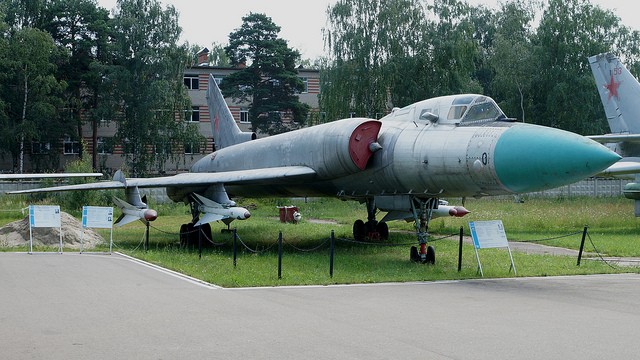
A Tu-128 sitting in Monino – Photo: Johnny Comstedt | Flickr CC
By the end of 1960, the first Tu-28 was produced (In December of 1963, the PVO renamed the program from Tu-28 to Tu-128 – there was no real merit for this decision being made) and moved from Lefortovo to Zhukovsky. First airborne on March 18, 1961, the Tu-28 took off with a giant under-fuselage fairing containing additional testing equipment. This fairing would remain throughout the entire flight test regimen.
So confusing to Western observers was this fairing, that when it was flown past the crowds at 1961’s Tushino aviation day, they assumed the Tu-28 was some sort of new bomber featuring a giant search radar.
Flight testing, especially for an aircraft of that era, went very smoothly. There was one incident in which an asymmetric missile firing resulted in the aircraft entering some sort of spiral dive, but this was not properly investigated nor written up (this would cause the tragic loss of an operational Tu-128 nine years later).
Slightly shorter than the Tu-98, the Tu-28 was still massive, especially for an interceptor. With a length of 98.62 feet, a wingspan of 57.51 feet, and a maximum takeoff weight of 96,342 pounds, it was as large as a modern Embraer 170!
The Tu-28 was also designed to be easy to mass-produce. None of the technology in the airframe was on the bleeding-edge, except for the method of installation of integral fuel-tanks into the relatively-thin wings.
April 1965 marked the PVO finally receiving their first brand-new Tu-128.
There was a rather glaring oversight on their part. Aircraft such as the Mig-19 had not required a dedicated, follow-on trainer for pilots that had advanced to it from earlier PVO aircraft such as the Mig-15 or Mig-17.
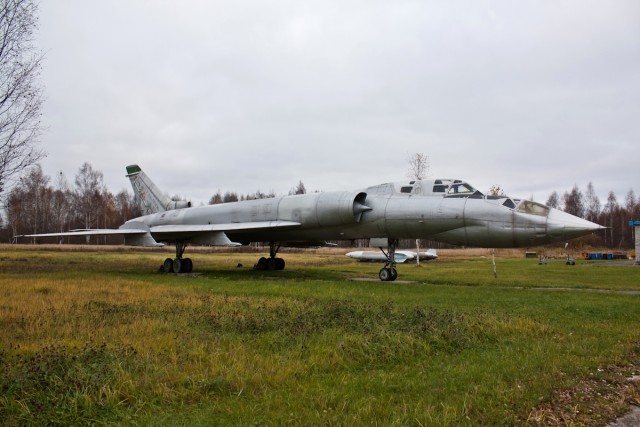
The only surviving TU-128UT is on display in the city of Rzhev – Photo: Alexey Vlasov
When aircraft 1405 crash-landed at Talagi, due to a pilot having no idea how to land such a massive aircraft, it wasn’t written off. Instead, it was taken back to Zhukovsky for modification by Tupolev. In order to retain the proper view from the flight deck, the instructor’s cockpit was mounted in a pod where the radar once sat. Officially referred to as the Tu-128UT, it was more commonly known to PVO crews as the Pelican. Fourteen were built; four converted from in-service aircraft, and the remainder modified new construction.
While this was all going on, American bomber tactics had changed. Originally a Tu-128 would take off to intercept American strategic bombers at stratospheric heights. They would intercept them before they reached stand-off munitions launch points by detecting them 30 miles from the aircraft, locking 25 miles out, and engaging with the R-4 missiles. Firing one infra-red and one semi-active radar-homing set per target, they would fly at a speed of around Mach 1.6 to a target a maximum of 15.5 miles away. These were not small missiles. Seventeen feet long, they weighed 1086lbs, 118 of that warhead. They merely had to explode close to a B-52 to do some serious damage. When all the missiles were expended, it was assumed that the Tu-128 would conduct a ramming attack against the opposing bomber fleet.
Would this have worked? Maybe.
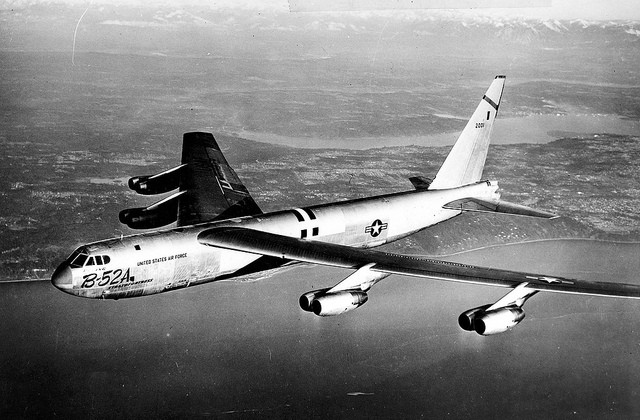
A Boeing B-52A – Photo: US Air Force
At 40,000 feet, a B-52 was also capable of pulling +2.5g, the same as the Tu-128. In a pinch, it could probably pull even more due to having lower wing loading. It is not impossible to assume that a B-52 would have had a chance in out-turning a Tu-128.
The ECM suite on the B-52 was very advanced for the day – and constantly being upgraded. It may have been able to fool one, if not both, of the missiles flying towards it. B-52s of that era also had one notable feature that would make attacks a little more difficult: a tail gun (missiles attacked from behind).
The Tu-128 was successful in terms of changing American tactics. The B-52 was not an aircraft known for fuel efficiency at low level, and the presence of Tu-128s would force the B-52s to descend to lower altitudes to penetrate Soviet airspace beyond the range of the Tu-128’s envelope. This would burn more fuel, which would take some targets out of the American engagement envelope.
Thing is, the later-model B-52s were designed to be more efficient at low altitude to continue the game of cat-and-mouse against the PVO.
The original Tu-128 Smerch system was great for finding targets at or above the altitude of the aircraft carrying it. Completely useless for any below. Because of this, beginning in 1970, Tupolev and the PVO worked to establish the Tu-128S-4M, commonly abbreviated as Tu-128M. The Tu-128M would feature both improved missiles and an updated Smerch radar that would allow it to detect targets down to 1,500 feet.
The increased heat generated by the avionics at these altitudes warranted the installation of additional air intakes to cool the electronics. Almost every Tu-128 was upgraded to the M-standard.
When Strategic Air Command found out about the lack of ability to detect targets lower than 1,500 feet, the decision was made for some B-52 crews to penetrate Soviet airspace at even lower altitudes. The range penalty was fairly brutal.
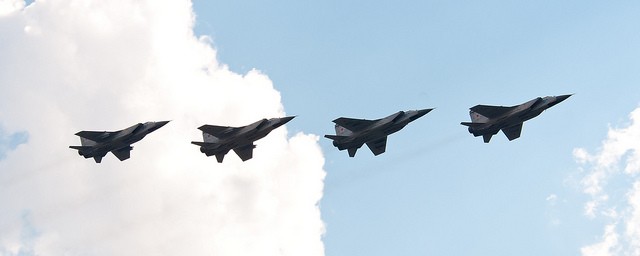
Four Mikoyan MiG-31s flying in formation -Photo: Sergey Vladimirov | Flickr CC
While this was going on, there were two attempts to make a more-effective Tu-128. The first was called the Tu-138 – it would feature new engines as well as an advanced version of the Smerch radar. Due to its larger engines, the wing had to be re-profiled. There was no way this aircraft could either land safely or cruise for 4.5 hours (an hour more than the Tu-128) as originally planned, so the project was cancelled when the faults were found in wind tunnel testing.
The final version of the Tu-128 was to be the Tu-148. It would feature Kolesov RD-36 engines and a variable-geometry wing. As a capstone it would feature the all-new, electronically-scanned Zaslon radar that would later be installed in Mig-31s. This would allow it to engage targets at any altitude. This behemoth, now with engines of the Tu-144, would have a loiter time of five hours. Earlier, in 1969, Tupolev had pitched a tactical bomber version of the Tu-128, a cruise missile carrier, and a dedicated electronic warfare aircraft.
In the end, 198 Tu-128s were produced. By the mid 1980s, the Tu-128’s performance was eclipsed in all ways by the much more modern Mig-31, though some regiments would operate the equally-menacing Su-27 as a replacement aircraft.
Those that were not scrapped in place were all flown to the city of Rzhev for scrapping. Four Tu-128s survive to this day as museum artifacts.
